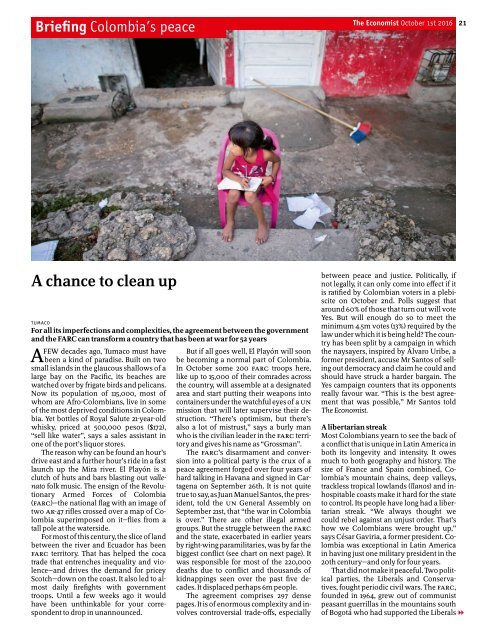You also want an ePaper? Increase the reach of your titles
YUMPU automatically turns print PDFs into web optimized ePapers that Google loves.
Briefing Colombia’s peace<br />
<strong>The</strong> <strong>Economist</strong> October 1st 2016 21<br />
A chance to clean up<br />
TUMACO<br />
Forall its imperfections and complexities, the agreement between the government<br />
and the FARC can transform a country that has been at warfor52 years<br />
AFEW decades ago, Tumaco must have<br />
been a kind of paradise. Built on two<br />
small islands in the glaucous shallows of a<br />
large bay on the Pacific, its beaches are<br />
watched over by frigate birds and pelicans.<br />
Now its population of 115,000, most of<br />
whom are Afro-Colombians, live in some<br />
of the most deprived conditions in Colombia.<br />
Yet bottles of Royal Salute 21-year-old<br />
whisky, priced at 500,000 pesos ($172),<br />
“sell like water”, says a sales assistant in<br />
one ofthe port’s liquor stores.<br />
<strong>The</strong> reason why can be found an hour’s<br />
drive east and a further hour’s ride in a fast<br />
launch up the Mira river. El Playón is a<br />
clutch of huts and bars blasting out vallenato<br />
folk music. <strong>The</strong> ensign of the Revolutionary<br />
Armed Forces of Colombia<br />
(FARC)—the national flag with an image of<br />
two AK-47 rifles crossed over a map of Colombia<br />
superimposed on it—flies from a<br />
tall pole at the waterside.<br />
Formost ofthis century, the slice ofland<br />
between the river and Ecuador has been<br />
FARC territory. That has helped the coca<br />
trade that entrenches inequality and violence—and<br />
drives the demand for pricey<br />
Scotch—down on the coast. It also led to almost<br />
daily firefights with government<br />
troops. Until a few weeks ago it would<br />
have been unthinkable for your correspondent<br />
to drop in unannounced.<br />
But if all goes well, El Playón will soon<br />
be becoming a normal part of Colombia.<br />
In October some 200 FARC troops here,<br />
like up to 15,000 of their comrades across<br />
the country, will assemble at a designated<br />
area and start putting their weapons into<br />
containersunderthe watchful eyesof a UN<br />
mission that will later supervise their destruction.<br />
“<strong>The</strong>re’s optimism, but there’s<br />
also a lot of mistrust,” says a burly man<br />
who is the civilian leader in the FARC territory<br />
and gives his name as “Grossman”.<br />
<strong>The</strong> FARC’s disarmament and conversion<br />
into a political party is the crux of a<br />
peace agreement forged over four years of<br />
hard talking in Havana and signed in Cartagena<br />
on September 26th. It is not quite<br />
true to say, asJuan Manuel Santos, the president,<br />
told the UN General Assembly on<br />
September 21st, that “the war in Colombia<br />
is over.” <strong>The</strong>re are other illegal armed<br />
groups. But the struggle between the FARC<br />
and the state, exacerbated in earlier years<br />
by right-wing paramilitaries, was by far the<br />
biggest conflict (see chart on next page). It<br />
was responsible for most of the 220,000<br />
deaths due to conflict and thousands of<br />
kidnappings seen over the past five decades.<br />
It displaced perhaps 6m people.<br />
<strong>The</strong> agreement comprises 297 dense<br />
pages. It is ofenormous complexity and involves<br />
controversial trade-offs, especially<br />
between peace and justice. Politically, if<br />
not legally, it can only come into effect if it<br />
is ratified by Colombian voters in a plebiscite<br />
on October 2nd. Polls suggest that<br />
around 60% ofthose that turn out will vote<br />
Yes. But will enough do so to meet the<br />
minimum 4.5m votes (13%) required by the<br />
lawunderwhich itisbeingheld? <strong>The</strong> country<br />
has been split by a campaign in which<br />
the naysayers, inspired by Álvaro Uribe, a<br />
former president, accuse Mr Santos of selling<br />
out democracy and claim he could and<br />
should have struck a harder bargain. <strong>The</strong><br />
Yes campaign counters that its opponents<br />
really favour war. “This is the best agreement<br />
that was possible,” Mr Santos told<br />
<strong>The</strong> <strong>Economist</strong>.<br />
A libertarian streak<br />
Most Colombians yearn to see the back of<br />
a conflict that is unique in Latin America in<br />
both its longevity and intensity. It owes<br />
much to both geography and history. <strong>The</strong><br />
size of France and Spain combined, Colombia’s<br />
mountain chains, deep valleys,<br />
trackless tropical lowlands (llanos) and inhospitable<br />
coasts make it hard for the state<br />
to control. Its people have long had a libertarian<br />
streak. “We always thought we<br />
could rebel against an unjust order. That’s<br />
how we Colombians were brought up,”<br />
says César Gaviria, a former president. Colombia<br />
was exceptional in Latin America<br />
in having just one military president in the<br />
20th century—and only for four years.<br />
Thatdid notmake itpeaceful. Two political<br />
parties, the Liberals and Conservatives,<br />
fought periodic civil wars. <strong>The</strong> FARC,<br />
founded in 1964, grew out of communist<br />
peasant guerrillas in the mountains south<br />
of Bogotá who had supported the Liberals 1


